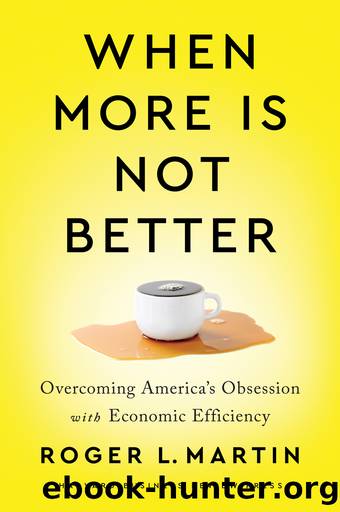When More Is Not Better by Roger L. Martin;

Author:Roger L. Martin;
Language: eng
Format: epub
Publisher: Lightning Source Inc. (Tier 2)
Published: 2020-08-09T16:00:00+00:00
Chapter 7
An Agenda for Political Leaders
September 2008 was a particularly bad month for American political leaders, whether elected politicians or senior government administrators. The financial turbulence that began in 2007 reached a crescendo in September 2008. On September 6, the Treasury Department was obliged to provide a $100 billion bailout for Fannie Mae and Freddie Mac, the federally backed mortgage-guarantee agencies Congress had created in 1938 and 1970, respectively, in order to promote American home ownership. On September 14, Lehman Brothers (of Repo 105 fame) declared bankruptcy due to its heavy exposure to mortgage-backed bonds, having failed to obtain a bailout from the Federal Reserve Bank and the Treasury, which deemed the investment bank small enough to fail. Just two days later, however, the impending collapse of insurance giant American International Group (AIG) forced the Federal Reserve to intervene with an initial $85 billion bailout (later increased). On September 25, the Office of Thrift Supervision seized Washington Mutual, the country’s largest savings-and-loan bank and placed it into receivership.
Three days later, on September 28, Congress refused to approve the more comprehensive bailout program, the Troubled Asset Relief Program (TARP). That rejection precipitated a 777.68-point drop in the Dow Jones Industrial Average on September 29, the biggest drop in history to that point, forcing Congress to reverse course, with the eventual passage of TARP on October 3. But the damage to confidence had already been done. Between September 19 and October 10, the Dow dropped 31 percent—the biggest one-month drop since another miserable fall month on Wall Street: September 1929. Banks stopped lending, even to their best clients. Commercial-paper programs, which had become a key source of short-term funding for large companies, stopped being supported by the financial intermediaries, threatening the solvency of even blue-chip industrials.1 America’s six largest banks all received assistance ranging from $10 to $25 billion from the TARP program to ensure their solvency and their continued ability to provide service to their customers.2 Nonetheless, the economy went into deep recession and unemployment soared, leading to one of the slowest economic recoveries in US history.
The six biggest US banks that received TARP funding are the first, second, third, fourth, seventh, and eighth largest banks in North America. On the same list, Canada’s “Big 5” banks ranked fifth, sixth, ninth, tenth, and eleventh.3 But unlike the six big US banks (and many smaller US banks), the five big Canadian banks did not receive or require bailout money from their government. Despite its close proximity to and interdependence with the US economy, the Canadian financial system did not experience a crisis of confidence and did not require the huge bank bailout programs that took place in the United States and most of the world’s advanced economies—from that of the United Kingdom to those of most of Europe and Australia.4
There were of course many factors behind this difference; there is never just one. But at the very least Canada’s policy approach to this vital sector has to be considered as one important
Download
This site does not store any files on its server. We only index and link to content provided by other sites. Please contact the content providers to delete copyright contents if any and email us, we'll remove relevant links or contents immediately.
The Bullet Journal Method by Ryder Carroll(2344)
The 7 Habits of Highly Effective People by Stephen R. Covey & Sean Covey(2060)
The Concise Laws of Human Nature by Robert Greene(1665)
Doesn't Hurt to Ask by Trey Gowdy(1542)
Hook Point: How to Stand Out in a 3-Second World by Brendan Kane(1091)
Primal Leadership by Daniel Goleman(1086)
HBR's 10 Must Reads 2021 by unknow(1037)
Don't Sweat the Small Stuff...and It's All Small Stuff by Richard Carlson(999)
Amazon Unbound by Brad Stone(967)
100 Things Successful People Do by Nigel Cumberland(953)
HBR's 10 Must Reads 2021 by Harvard Business Review(945)
The Job Closer by Steve Dalton(929)
Master of One by Jordan Raynor(926)
Lives of the Stoics by Ryan Holiday & Stephen Hanselman(887)
Declutter Your Mind: A step by step guide to learn to control your thoughts, stop worrying, relieve anxiety and eliminate panic attacks and negative thinking by Mia Chandler(863)
The Power of 100! by Shaun King(788)
Conflicted by Ian Leslie(782)
Coders at Work: Reflections on the craft of programming by Peter Seibel(773)
The Book of Hope by Jane Goodall(732)
